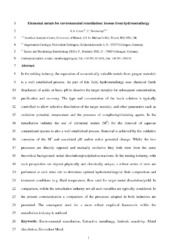Elemental metals for environmental remediation: lessons from hydrometallurgy
Preprint2012
Crane, R. A.; Noubactep, C., 2012: Elemental metals for environmental remediation: lessons from hydrometallurgy. In: Crane, R.A.; Noubactep, C. (2012): Elemental metals for environmental remediation: lessons from hydrometallurgy, DOI: 10.23689/fidgeo-2523.
 |
Dokument öffnen: |
In the mining industry, the separation of economically valuable metals from gangue materials
is a well established process. As part of this field, hydrometallurgy uses chemical fluids
(leachates) of acidic or basic pH to dissolve the target metal(s) for subsequent concentration,
purification and recovery. The type and concentration of the leach solution is typically
controlled to allow selective dissolution of the target metal(s), and other parameters such as
oxidation potential, temperature and the presence of complexing/chelating agents. In the
remediation industry the use of elemental metals (M0) for the removal of aqueous
contaminant species is also a well established process. Removal is achieved by the oxidative
corrosion of the M0 and associated pH and/or redox potential change. Whilst the two
processes are directly opposed and mutually exclusive they both stem from the same
theoretical background: metal dissolution/precipitation reactions. In the mining industry, with
each prospective ore deposit physically and chemically unique, a robust series of tests are
performed at each mine site to determine optimal hydrometallurgical fluid composition and
treatment conditions (e.g. fluid temperature, flow rate) for target metal dissolution/yield. In
comparison, within the remediation industry not all such variables are typically considered. In
the present communication a comparison of the processes adopted in both industries are
presented. The consequent need for a more robust empirical framework within the
remediation industry is outlined.
Statistik:
ZugriffsstatistikSammlung:
- Geologie [933]

